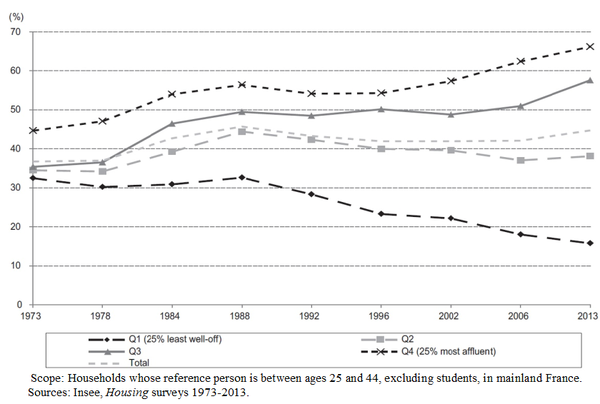Economie et Statistique / Economics and Statistics n° 500-501-502 - 2018 Rising inequalities in access to home ownership among young households in France, 1973-2013
THE ARTICLE ON ONE PAGE
Key question
In France, for the past 40 years or so, home ownership among young households (25 to 44 years old) seems to be holding steady. Behind this apparent stability, however, have developments been similar for all young households, whether modest or well-off? What has been the influence of changes in family configurations or trends in locations, in rural or urban areas, on first-time home ownership? And what role has the aid (gift assistance, inheritances and other forms) provided by the family played?
Methodology
The long-term trend in ownership rate is analysed on the basis of the national Housing Surveys (Insee) from 1973 to 2013. An "Oaxaca-Blinder"-type breakdown is used to assess the contribution of various factors, including family assistance, to changes in home ownership rates by standard of living.
Main results
- Among young households, inequalities in access to property and real estate wealth acquired have increased between the least well-off and the best-off over the last forty years: the share of owners has increased for young wealthy households, from 45% in 1973 to 66% in 2013; on the other hand, 32% of young less well-off households were owners in 1973, compared to only 16% in 2013.
- More than 60% of this decline among young less well-off households is due to changes in the structure of this population over time: increasing share of single-parent families, decline in the share of couples with children and sharp decline in small rural home ownership.
- The probability of becoming a homeowner is higher for young households that have received help from their families. This played an important role in the 2000s: four out of ten recent owners have benefited from it. This proportion increased sharply among wealthier households, contributing to the widening gap with the share of the least well-off homeowners.
graphiqueShare of homeowners among young households by standard of living quartile 1973-2013

Main message
The apparent stability of home ownership among young households between 1973 and 2013 masks growing disparities between the affluent and the less well-off. The important and growing role of family financial support puts the spotlight on how inequalities in home ownership are passed down from generation to generation. This invites in-depth analysis of the influence of family assistance not only on home ownership, but on other dimensions of possible inequality, such as the quality and location of the housing acquired.
Article on one page (pdf, 269 Ko )


